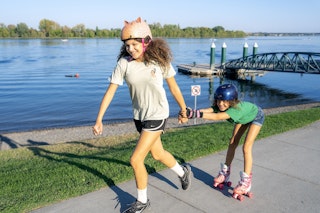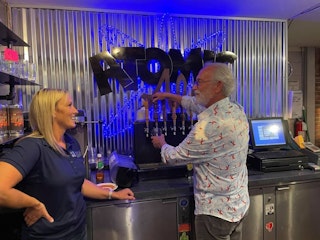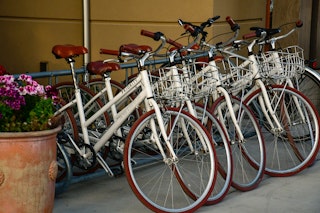Honor and Celebrate the Indigenous People of the Mid-Columbia
Today, the Tri-Cities is known as a gathering place for great wine, good food and fantastic river vistas.
However, the history of Tri-Cities began thousands of years ago, beginning with the Ice Age Floods that shaped the land and created the perfect agricultural environment for indigenous people to survive and thrive.
Tri-Cities offers much to explore with historical sites, art installations and designated markers that pay tribute to the rich history and traditions of the people who lived in the Columbia River Plateau.
The Gathering Place
The Tri-Cities offers visitors opportunities to recognize and honor the fact that the region we know and love is on the land of the Confederated Tribes of the Umatilla Indian Reservation (CTUIR), which encompasses the Cayuse, Umatilla and Walla Walla Tribes.
Clover Island in Kennewick not only has great river access and amazing views of the Cable Bridge, it’s home to beautiful art installations celebrating the indigenous people of the Columbia River Plateau, which includes the Tri-Cities. The Confederated Tribes of the Umatilla Indian Reservation have a longstanding friendship and strong partnership with the Port of Kennewick. The two organizations have worked together to develop art installations and gathering places that celebrate the heritage and culture of the CTUIR.
The Gathering Place or Wiyákuktpa, displays the Confederated Tribes of the Umatilla Indian Reservation’s customs and traditions of gathering tule reed around Ánwas (Clover Island). The installation features bronze statues of a traditionally adorned person looking toward another in contemporary attire around a pond. The figures symbolize the CTUIR’s past present and future.
The Gathering Place also features four artistic renditions of sapáx0ikas, meaning “willow fish traps.” The artwork honors the Tribes’ tradition of capturing fish by placing large basket-like traps, woven from willows and weighted with rocks, into the Columbia River. The Tribes lived by the seasons, following an annual cycle of gathering, fishing, hunting, trading, and preparing for the next season. The traditions have been passed down through the generations and continue to be practiced.
Story Circles
At the confluence of the Columbia and Snake Rivers is a tree-lined oasis known as Sacajawea State Park, named after Sacagawea, the Shoshone woman who was critical to the success of the Lewis & Clark Expedition. Sacagawea was an interpreter and an emissary of peace between the white explorers and Native American tribes. The State Park location marks the campsite of the Lewis & Clark Expedition as they made their way to the Pacific Ocean.
Discover the rich cultural history of the Columbia River Plateau at the Sacajawea Interpretive Center located in the State Park. The museum features interactive exhibits on the Corps of Discovery, Sacagawea and the Sahaptian-speaking tribes of the region. Then explore the ground and read the seven story circle installations by an internationally known artist
Sacagwea Heritage Trail
The Sacagawea Heritage Trail is a 23-mile recreation and educational trail along the Columbia River shoreline dedicated to Sacagawea. The trail is a paved loop, connecting Kennewick, Pasco and Richland.
The Sacagawea Heritage Trail offers an amazing outdoor experience through the region’s unique shrub-steppe habitat while sharing the experiences of Sacagawea and Lewis & Clark Expedition with interpretive markers, such as Pompy’s Lessons and the Lewis & Clark Interpretive Overlook in Richland.
To learn more about these events, or to find other free activities, check out VisitTri-Cities.com/events.
Other points of interest to learn about the indigenous people of the Columbia River Plateau:
Benton County Historical Museum 7th and Paterson, Prosser - 509.786.3842
This wonderful museum showcases more than 20,000 items and "brings the past into the future." Items of interest include 1843 - 1920 gowns, a wildlife diorama, a general store, and numerous indigenous artifacts.
East Benton County Historical Museum 205 Keewaydin Drive, Kennewick - 509.582.7704
See the pioneers who followed the mighty explorers, Lewis and Clark. Colorful displays depict the hardships and successes experienced by the area's founding families. And don't miss the Kennewick Man exhibit! Kennewick Man, the skeleton found on the banks of the Columbia River in 1996 is the center of a display in the East Benton County Museum. The display depicts the skeleton on a river bank with a panoramic view of Rattlesnake Mountain in the background. The skull on display is a casting of the original skull found. Four reader boards and other information that is updated with current information accompanies the display.
Franklin County Historical Museum 305 N. 4th Ave., Pasco - 509.547.3714
Located in a former Carnegie Library, the Museum itself is listed in on the National Historic Register. American Indian, pioneer, aviation, and railroad exhibits give insight into our region's unique place in history. View wartime memorabilia and the local archive of acclaimed Hollywood cinematographer, James Wong Howe.
The Tri-Cities Airport in Pasco is celebrating the Tribes through 2022 with art exhibits throughout the airport. Themed as “We Were, We Are, and We Will Be,” the exhibit provides a local historical and cultural perspective on Native Americans and their impact on the region while also educating passengers about the existence of the nearby Tamástslikt Cultural Institute, the only museum on the Oregon Trail that tells the story of Western expansionism from a tribal point of view.
Tri-IDEAs is a program exploring and celebrating Inclusivity, Diversity, Equity and Accessibility through tourism in the Tri-Cities.
At Visit Tri-Cities, we believe travel is transformative on multiple levels. Exploring new destinations exposes us to different ideas, cultures, history, heritages and people. Through Tri-IDEAs, Visit Tri-Cities will connect with local business owners, community leaders, event organizers, residents and more to highlight, share and celebrate the diversity of the Tri-Cities that can be experienced through travel and tourism activities.
































